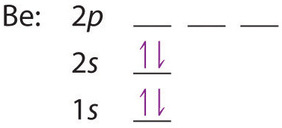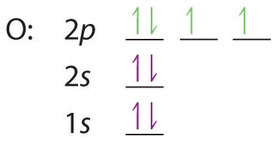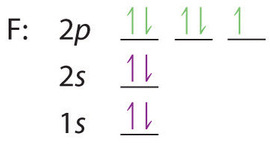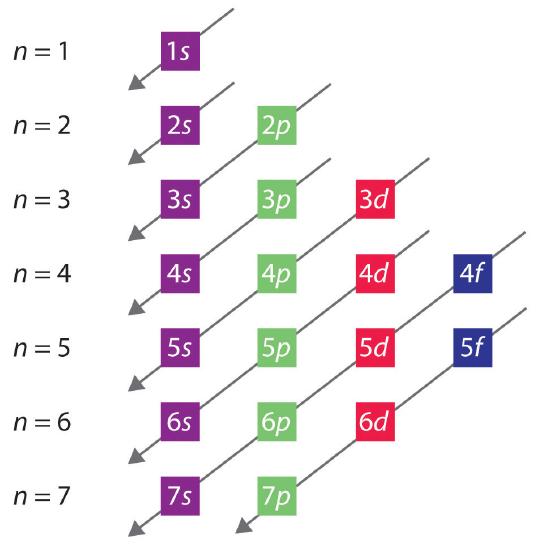Predict the Ground State Electron Configuration W3+
6.8: Electron Configurations
-
- Last updated
- Save as PDF
- Page ID
- 21735
Learning Objectives
- To understand the basics of adding electrons to atomic orbitals
- To understand the basics of the Aufbau principle
The electron configuration of an element is the arrangement of its electrons in its atomic orbitals. By knowing the electron configuration of an element, we can predict and explain a great deal of its chemistry.
The Aufbau Principle
We construct the periodic table by following the aufbau principle (from German, meaning "building up"). First we determine the number of electrons in the atom; then we add electrons one at a time to the lowest-energy orbital available without violating the Pauli principle. We use the orbital energy diagram of Figure \(\PageIndex{1}\), recognizing that each orbital can hold two electrons, one with spin up ↑, corresponding to m s = +½, which is arbitrarily written first, and one with spin down ↓, corresponding to m s = −½. A filled orbital is indicated by ↑↓, in which the electron spins are said to be paired. Here is a schematic orbital diagram for a hydrogen atom in its ground state:

From the orbital diagram, we can write the electron configuration in an abbreviated form in which the occupied orbitals are identified by their principal quantum number n and their value of l (s, p, d, or f), with the number of electrons in the subshell indicated by a superscript. For hydrogen, therefore, the single electron is placed in the 1s orbital, which is the orbital lowest in energy (Figure \(\PageIndex{1}\)), and the electron configuration is written as 1s 1 and read as "one-s-one."
A neutral helium atom, with an atomic number of 2 (Z = 2), has two electrons. We place one electron in the orbital that is lowest in energy, the 1s orbital. From the Pauli exclusion principle, we know that an orbital can contain two electrons with opposite spin, so we place the second electron in the same orbital as the first but pointing down, so that the electrons are paired. The orbital diagram for the helium atom is therefore

written as 1s 2, where the superscript 2 implies the pairing of spins. Otherwise, our configuration would violate the Pauli principle.
The next element is lithium, with Z = 3 and three electrons in the neutral atom. We know that the 1s orbital can hold two of the electrons with their spins paired; the third electron must enter a higher energy orbital. Figure 6.29 tells us that the next lowest energy orbital is 2s, so the orbital diagram for lithium is

This electron configuration is written as 1s 22s 1.
The next element is beryllium, with Z = 4 and four electrons. We fill both the 1s and 2s orbitals to achieve a 1s 22s 2 electron configuration:

When we reach boron, with Z = 5 and five electrons, we must place the fifth electron in one of the 2p orbitals. Because all three 2p orbitals are degenerate, it doesn't matter which one we select. The electron configuration of boron is 1s 22s 22p 1:

At carbon, with Z = 6 and six electrons, we are faced with a choice. Should the sixth electron be placed in the same 2p orbital that already has an electron, or should it go in one of the empty 2p orbitals? If it goes in an empty 2p orbital, will the sixth electron have its spin aligned with or be opposite to the spin of the fifth? In short, which of the following three orbital diagrams is correct for carbon, remembering that the 2p orbitals are degenerate?
Because of electron-electron interactions, it is more favorable energetically for an electron to be in an unoccupied orbital than in one that is already occupied; hence we can eliminate choice a. Similarly, experiments have shown that choice b is slightly higher in energy (less stable) than choice c because electrons in degenerate orbitals prefer to line up with their spins parallel; thus, we can eliminate choice b. Choice c illustrates Hund's rule (named after the German physicist Friedrich H. Hund, 1896–1997), which today says that the lowest-energy electron configuration for an atom is the one that has the maximum number of electrons with parallel spins in degenerate orbitals. By Hund's rule, the electron configuration of carbon, which is 1s 22s 22p 2, is understood to correspond to the orbital diagram shown in c. Experimentally, it is found that the ground state of a neutral carbon atom does indeed contain two unpaired electrons.
When we get to nitrogen (Z = 7, with seven electrons), Hund's rule tells us that the lowest-energy arrangement is

with three unpaired electrons. The electron configuration of nitrogen is thus 1s 22s 22p 3.
At oxygen, with Z = 8 and eight electrons, we have no choice. One electron must be paired with another in one of the 2p orbitals, which gives us two unpaired electrons and a 1s 22s 22p 4 electron configuration. Because all the 2p orbitals are degenerate, it doesn't matter which one has the pair of electrons.

Similarly, fluorine has the electron configuration 1s 22s 22p 5:

When we reach neon, with Z = 10, we have filled the 2p subshell, giving a 1s 22s 22p 6 electron configuration:

Notice that for neon, as for helium, all the orbitals through the 2p level are completely filled. This fact is very important in dictating both the chemical reactivity and the bonding of helium and neon, as you will see.
Electron Configuration of Atoms: https://youtu.be/LlY-O3-bfnk
Valence Electrons
As we continue through the periodic table in this way, writing the electron configurations of larger and larger atoms, it becomes tedious to keep copying the configurations of the filled inner subshells. In practice, chemists simplify the notation by using a bracketed noble gas symbol to represent the configuration of the noble gas from the preceding row because all the orbitals in a noble gas are filled. For example, [Ne] represents the 1s 22s 22p 6 electron configuration of neon (Z = 10), so the electron configuration of sodium, with Z = 11, which is 1s 22s 22p 63s 1, is written as [Ne]3s 1:
| Neon | Z = 10 | 1s 22s 22p 6 |
| Sodium | Z = 11 | 1s 22s 22p 6 3 s 1 = [Ne]3 s 1 |
Because electrons in filled inner orbitals are closer to the nucleus and more tightly bound to it, they are rarely involved in chemical reactions. This means that the chemistry of an atom depends mostly on the electrons in its outermost shell, which are called the valence electrons . The simplified notation allows us to see the valence-electron configuration more easily. Using this notation to compare the electron configurations of sodium and lithium, we have:
| Sodium | 1s 22s 22p 63s 1 = [Ne]3s 1 |
| Lithium | 1s 22s 1 = [He]2s 1 |
It is readily apparent that both sodium and lithium have one s electron in their valence shell. We would therefore predict that sodium and lithium have very similar chemistry, which is indeed the case.
As we continue to build the eight elements of period 3, the 3s and 3p orbitals are filled, one electron at a time. This row concludes with the noble gas argon, which has the electron configuration [Ne]3s 23p 6, corresponding to a filled valence shell.
Example \(\PageIndex{1}\): Electronic Configuration of Phosphorus
Draw an orbital diagram and use it to derive the electron configuration of phosphorus, Z = 15. What is its valence electron configuration?
Given: atomic number
Asked for: orbital diagram and valence electron configuration for phosphorus
Strategy:
- Locate the nearest noble gas preceding phosphorus in the periodic table. Then subtract its number of electrons from those in phosphorus to obtain the number of valence electrons in phosphorus.
- Referring to Figure \(\PageIndex{1}\), draw an orbital diagram to represent those valence orbitals. Following Hund's rule, place the valence electrons in the available orbitals, beginning with the orbital that is lowest in energy. Write the electron configuration from your orbital diagram.
- Ignore the inner orbitals (those that correspond to the electron configuration of the nearest noble gas) and write the valence electron configuration for phosphorus.
Solution:
A Because phosphorus is in the third row of the periodic table, we know that it has a [Ne] closed shell with 10 electrons. We begin by subtracting 10 electrons from the 15 in phosphorus.
B The additional five electrons are placed in the next available orbitals, which Figure \(\PageIndex{1}\) tells us are the 3s and 3p orbitals:

Because the 3s orbital is lower in energy than the 3p orbitals, we fill it first:

Hund's rule tells us that the remaining three electrons will occupy the degenerate 3p orbitals separately but with their spins aligned:

The electron configuration is [Ne]3s 23p 3.
C We obtain the valence electron configuration by ignoring the inner orbitals, which for phosphorus means that we ignore the [Ne] closed shell. This gives a valence-electron configuration of 3s 23p 3.
Exercise \(\PageIndex{1}\)
Draw an orbital diagram and use it to derive the electron configuration of chlorine, Z = 17. What is its valence electron configuration?
- Answer
-
[Ne]3s 23p 5; 3s 23p 5
Definition of Valence Electrons: https://youtu.be/_ldxOYwM2VM
The general order in which orbitals are filled is depicted in Figure \(\PageIndex{2}\). Subshells corresponding to each value of n are written from left to right on successive horizontal lines, where each row represents a row in the periodic table. The order in which the orbitals are filled is indicated by the diagonal lines running from the upper right to the lower left. Accordingly, the 4s orbital is filled prior to the 3d orbital because of shielding and penetration effects. Consequently, the electron configuration of potassium, which begins the fourth period, is [Ar]4s 1, and the configuration of calcium is [Ar]4s 2. Five 3d orbitals are filled by the next 10 elements, the transition metals, followed by three 4p orbitals. Notice that the last member of this row is the noble gas krypton (Z = 36), [Ar]4s 23d 104p 6 = [Kr], which has filled 4s, 3d, and 4p orbitals. The fifth row of the periodic table is essentially the same as the fourth, except that the 5s, 4d, and 5p orbitals are filled sequentially.

The sixth row of the periodic table will be different from the preceding two because the 4f orbitals, which can hold 14 electrons, are filled between the 6s and the 5d orbitals. The elements that contain 4f orbitals in their valence shell are the lanthanides. When the 6p orbitals are finally filled, we have reached the next noble gas, radon (Z = 86), [Xe]6s 24f 145d 106p 6 = [Rn]. In the last row, the 5f orbitals are filled between the 7s and the 6d orbitals, which gives the 14 actinide elements. Because the large number of protons makes their nuclei unstable, all the actinides are radioactive.
Example \(\PageIndex{2}\): Electron Configuration of Mercury
Write the electron configuration of mercury (Z = 80), showing all the inner orbitals.
Given: atomic number
Asked for: complete electron configuration
Strategy:
Using the orbital diagram in Figure \(\PageIndex{1}\) and the periodic table as a guide, fill the orbitals until all 80 electrons have been placed.
Solution:
By placing the electrons in orbitals following the order shown in Figure \(\PageIndex{2}\) and using the periodic table as a guide, we obtain
| 1s 2 | row 1 | 2 electrons |
| 2s 22p 6 | row 2 | 8 electrons |
| 3s 23p 6 | row 3 | 8 electrons |
| 4s 23d 104p 6 | row 4 | 18 electrons |
| 5s 24d 105p 6 | row 5 | 18 electrons |
| row 1–5 | 54 electrons |
After filling the first five rows, we still have 80 − 54 = 26 more electrons to accommodate. According to Figure \(\PageIndex{2}\), we need to fill the 6s (2 electrons), 4f (14 electrons), and 5d (10 electrons) orbitals. The result is mercury's electron configuration:
1s 22s 22p 63s 23p 64s 23d 104p 65s 24d 105p 66s 24f 145d 10 = Hg = [Xe]6s 24f 145d 10
with a filled 5d subshell, a 6s 24f 145d 10 valence shell configuration, and a total of 80 electrons. (You should always check to be sure that the total number of electrons equals the atomic number.)
Exercise \(\PageIndex{2}\): Electron Configuration of Flerovium
Although element 114 is not stable enough to occur in nature, atoms of element 114 were created for the first time in a nuclear reactor in 1998 by a team of Russian and American scientists. The element is named after the Flerov Laboratory of Nuclear Reactions of the Joint Institute for Nuclear Research in Dubna, Russia, where the element was discovered. The name of the laboratory, in turn, honors the Russian physicist Georgy Flyorov. Write the complete electron configuration for element 114.
- Answer
-
s 22s 22p 63s 23p 64s 23d 104p 65s 24d 105p 66s 24f 145d 106p 67s 25f 146d 107p 2
The electron configurations of the elements are presented in Figure \(\PageIndex{2}\), which lists the orbitals in the order in which they are filled. In several cases, the ground state electron configurations are different from those predicted by Figure \(\PageIndex{1}\). Some of these anomalies occur as the 3d orbitals are filled. For example, the observed ground state electron configuration of chromium is [Ar]4s 13d 5 rather than the predicted [Ar]4s 23d 4. Similarly, the observed electron configuration of copper is [Ar]4s 13d 10 instead of [Ar]s 23d 9. The actual electron configuration may be rationalized in terms of an added stability associated with a half-filled (ns 1, np 3, nd 5, nf 7) or filled (ns 2, np 6, nd 10, nf 14) subshell. (In fact, this "special stability" is really another consequence of the instability caused by pairing an electron with another in the same orbital, as illustrated by Hund's rule.) Given the small differences between higher energy levels, this added stability is enough to shift an electron from one orbital to another. In heavier elements, other more complex effects can also be important, leading to many additional anomalies. For example, cerium has an electron configuration of [Xe]6s 24f 15d 1, which is impossible to rationalize in simple terms. In most cases, however, these apparent anomalies do not have important chemical consequences.
Additional stability is associated with half-filled or filled subshells.
Electron Configuration of Transition Metals: https://youtu.be/HzpfE0fk_E0
Summary
Based on the Pauli principle and a knowledge of orbital energies obtained using hydrogen-like orbitals, it is possible to construct the periodic table by filling up the available orbitals beginning with the lowest-energy orbitals (the aufbau principle), which gives rise to a particular arrangement of electrons for each element (its electron configuration). Hund's rule says that the lowest-energy arrangement of electrons is the one that places them in degenerate orbitals with their spins parallel. For chemical purposes, the most important electrons are those in the outermost principal shell, the valence electrons.
Predict the Ground State Electron Configuration W3+
Source: https://chem.libretexts.org/Bookshelves/General_Chemistry/Map:_Chemistry_-_The_Central_Science_%28Brown_et_al.%29/06._Electronic_Structure_of_Atoms/6.8:_Electron_Configurations

0 Response to "Predict the Ground State Electron Configuration W3+"
Post a Comment